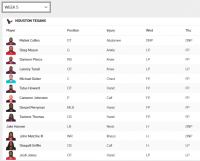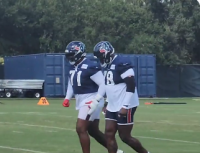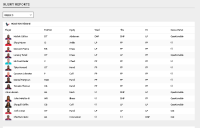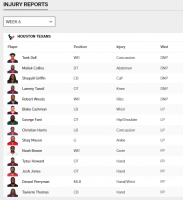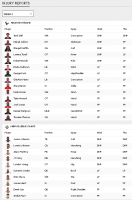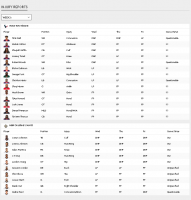Ouch! So essentially the only way he should play is as an emergency backup at guardYes. It's a painful injury that leaves your thumb essentially dangling free and no ability to grip.
Keep Texans Talk Google Ad Free!
Venmo Tip Jar | Paypal Tip Jar
Thanks for your support! 🍺😎👍
You are using an out of date browser. It may not display this or other websites correctly.
You should upgrade or use an alternative browser.
You should upgrade or use an alternative browser.
Injury Thread
- Thread starter CloakNNNdagger
- Start date
CloakNNNdagger
Hall of Fame
The thumb is no longer dangling after repair. But it is hard- splinted beneath the large padded club.........it's the lack of grip that will compromise him. Even at guard , loss of grip does not make realistic expectactions of a good performance.Ouch! So essentially the only way he should play is as an emergency backup at guard
CloakNNNdagger
Hall of Fame
CloakNNNdagger
Hall of Fame
Colins has suffered an oblique muscle strain.........even a Grade I is likely to keep him out 3-4 weeks.......this injury is notorious for extension if short cuts are attempted circumventing adequate rest/rehab. If setback occurs, recovery can be set in terms of monthsThe injury list just reported on 610 and Malik Collins did not practice and the talk is won't be playing Sunday.
CloakNNNdagger
Hall of Fame
Watch Tunsil at the 7 to 11 second mark of the video. He demonstrates a definite hitch in his step. That knee still appears to be bothersome.
CloakNNNdagger
Hall of Fame
Per Wilson >> Maliek Collins returned to practice from an abdominal injury, muscle injury, and is expected to play Sunday against the Falcons.Colins has suffered an oblique muscle strain.........even a Grade I is likely to keep him out 3-4 weeks.......this injury is notorious for extension if short cuts are attempted circumventing adequate rest/rehab. If setback occurs, recovery can be set in terms of months
First and only practice...........noncontact.............I don't know that I like this.
CloakNNNdagger
Hall of Fame
Alert, Alert!!!!! Perryman switched to a blue club from a red club on his hand today. 
Although he's practiced fully all week, that club is not going to help his tackling.

Although he's practiced fully all week, that club is not going to help his tackling.
Last edited:
Sweech
Onside Kick Specialist
Does the coloration signify anything?Alert, Alert!!!!! Perryman switched to a blue club from a red club on his hand today.
Although he's practiced fully all week, that club is not going to help his tackling.
NitroGSXR
Super Sic #58
Yeah… it means its not Battle Red Day anymore.Does the coloration signify anything?
CloakNNNdagger
Hall of Fame
I accidentally post this in the NFL thread ~1 hr ago.
**********************************************
The following were all limited today during essentially a walk-thru practice>>>>>>>>>
Griffin suffered a calf tear Wednesday............even Grade I, can't see him playing Sunday.
Hansen having suffered a neck stinger Thursday...............Sunday doesn't look promising.
M. Collins............if he plays which he shouldn't so soon, he will extend his injury.
Tunsil................still essentially limping..............shouldn't be playing.
Harris suffered a concussion in practice................safe to say, he won't clear the Protocol by Sunday.
Jones...........with or without a club, he will be compromised if he even tries to play.
Metchie is still having symptoms............unlikely to be effective if he plays Sunday.
**********************************************
The following were all limited today during essentially a walk-thru practice>>>>>>>>>
Griffin suffered a calf tear Wednesday............even Grade I, can't see him playing Sunday.
Hansen having suffered a neck stinger Thursday...............Sunday doesn't look promising.
M. Collins............if he plays which he shouldn't so soon, he will extend his injury.
Tunsil................still essentially limping..............shouldn't be playing.
Harris suffered a concussion in practice................safe to say, he won't clear the Protocol by Sunday.
Jones...........with or without a club, he will be compromised if he even tries to play.
Metchie is still having symptoms............unlikely to be effective if he plays Sunday.
CloakNNNdagger
Hall of Fame
Tytus Howard hasn't been signed to the 53, yet. But Rivers was released today to make room for someone. Assuming it's Howard, and except for the rust, will he be close to 100%?
I'm not sure about that............they are getting very short of linebackers. The Texans have been actively looking for a linebacker.
CloakNNNdagger
Hall of Fame
The Falcons have gone all week without a player being listed on the Injury Report.
CloakNNNdagger
Hall of Fame
I would prefer they just keep him out until after the bye... and probably Tunsil also@Number19 If Howard is wearing a bulky splint for a walk-thru practic, he will likely require a club to play in a game. Not very good for performance for the first time in a long time.
CloakNNNdagger
Hall of Fame
OptimisticTexan
2024 / Rebuilding Block 4 After Playoffs / Texans
The thumb is no longer dangling after repair. But it is hard- splinted beneath the large padded club.........it's the lack of grip that will compromise him. Even at guard , loss of grip does not make realistic expectactions of a good performance.
Man, unlike Baker….I truly hope Ryans knows when to pull a player who’s just not able to perform. There’s plenty of depth to work from.
CloakNNNdagger
Hall of Fame
Note that Stroud in the brief clip is performing band exercise (preferential to the right side) which is typically done for shoulder pain caused by rotator cuff or shoulder bursitus
CloakNNNdagger
Hall of Fame
From the Linebackers thread>
There are many small ligaments in the wrist. With a Grade II which is what it appears to be since Perryman has not had surgery (which would be required with a Grade III [rupture]), will require ~4-6 weeks of splint stabilization before removal of the club should be entertained. The injury occurred Sept 22. I should mention that Dec of last year, he suffered a wrist sprain. This history could prompt an even longer period of protection.TheRealJoker said:
Perryman should not be out there until he can play without a club. His best asset, his tackling, is compromised. Can’t make tackles with that club on. @CloakNNNdagger any idea when he’ll get that club off?
CloakNNNdagger
Hall of Fame
Dell is in the Concussion Protocol.
CloakNNNdagger
Hall of Fame
That's not correct............Through Week 4, 12 of 15 players have missed one game after suffering a concussion and just one of 15 have missed two games (Colts Center Ryan Kelly)..........Green Bay Packers LB Quay Walker returned in Week 2 despite a Week 1 concussion and Houston Texans safety Eric Murray made it back for Week 3 despite suffering a concussion the week prior. I haven't had time to check a week 5 update. It does seem that there is a lower return the next week than previous years.
Tunsil................still essentially limping..............shouldn't be playing.
If Tunsil sits, how many weeks would he need to become 100%?
CloakNNNdagger
Hall of Fame
CloakNNNdagger
Hall of Fame
If Tunsil sits, how many weeks would he need to become 100%?

I didn't think that he should have played last game while his knee was still inflamed and he was limping in practice. Having more than likely increased the inflammation and swelling after the game, his rest period would probably be best set at ~ 2 weeks........that is, if there is no cartilaginous fragment floating freely in the joint space in which case arthroscopic surgery would be indicated.

I didn't think that he should have played last game while his knee was still inflamed and he was limping in practice. Having more than likely increased the inflammation and swelling after the game, his rest period would probably be best set at ~ 2 weeks........that is, if there is no cartilaginous fragment floating freely in the joint space in which case arthroscopic surgery would be indicated.
Thanks. Is his injury chronic, as in recurring often?
CloakNNNdagger
Hall of Fame
I'm trying to explain to you that without seeing his MRI certain determinations cannot be made.....especially prognosis........and specifically long-term prognosis.Thanks. Is his injury chronic, as in recurring often?
I'm trying to explain to you that without seeing his MRI certain determinations cannot be made.....especially prognosis........and specifically long-term prognosis.
Ok thanks.
CloakNNNdagger
Hall of Fame
.........
CloakNNNdagger
Hall of Fame
With Dell not practicing today, don't expect him to clear the Protocol for Sunday.
sprtsfanatic
Veteran
yeah pretty much expected this one...next man up...either X. Hutch or N. Brown since he's ready to return...With Dell not practicing today, don't expect him to clear the Protocol for Sunday.
CloakNNNdagger
Hall of Fame
Shaq Griffin and M Collins have both returned to practice. Sunday return is too soon after a calf and oblique injury........very high risk for re-injury.
CloakNNNdagger
Hall of Fame
Is it normal to have this many hand/wrist injuries?
badboy
Hall of Fame
Looks like stitches?.........
CloakNNNdagger
Hall of Fame
The patterns in these retrospective studies have also essentially translated to the last 15 years.:Is it normal to have this many hand/wrist injuries?
****************************************************************************************************************************
Am J Sports Med
2008 Oct;36(10):1938-44.
doi: 10.1177/0363546508318197. Epub 2008 May 23.
Upper extremity injuries in the National Football League: part I: hand and digital injuries
Nathan A Mall 1, John C Carlisle, Matthew J Matava, John W Powell, Charles A Goldfarb
Affiliations expand
- PMID: 18502939
- DOI: 10.1177/0363546508318197
Background: Very little has been published regarding the incidence of and duration of time lost after hand injuries in professional American football players.
Hypotheses: (1) Hand, first ray, and finger injuries in professional American football players represent a common cause of missed time from practice and game participation. (2) The effect of upper extremity injuries differs as a function of the anatomic site involved, injury type, and athlete's position.
Study design: Descriptive epidemiologic study.
Methods: A retrospective review of all documented injuries to the hand, first ray, and fingers sustained by American football players in the National Football League over a 10-year period (1996-2005) was performed using the League's injury surveillance database. The data were analyzed from multiple perspectives, with emphasis on the type of injury, athlete position, and activity at the time of injury.
Results: A total of 1385 injuries occurred to the hand, first ray, and fingers over the 10 seasons studied. Of these injuries, 48% involved the fingers, 30% involved the first ray, and 22% involved the hand, with game injuries more common than practice injuries at each location. Metacarpal fractures and proximal interphalangeal joint dislocations were the 2 most common injuries. Offensive and defensive linemen were the most likely to sustain a hand injury; 80% of hand injuries were metacarpal fractures. The most common injuries to the first ray were fractures (48%) and sprains (36%), which occurred most often in athletes playing a defensive secondary position. Finger injuries were most commonly dislocations at the level of the proximal interphalangeal joint, typically involving the ulnar 2 digits. Finger injuries were most common in wide receivers and defensive secondary players. The act of tackling produced the most injuries (28%).
Conclusion: Upper extremity trauma, especially injury to the hand, first ray, and fingers, is a significant source of morbidity for professional football players. The results of this study may be used to implement preventive measures to help minimize these injuries.
******************************************************************************************************************************************************************************
Am J Sports Med
. 2008 Oct;36(10):1945-52.
doi: 10.1177/0363546508318198. Epub 2008 Jun 26.
Upper extremity injuries in the National Football League: part II: elbow, forearm, and wrist injuries
John C Carlisle 1, Charles A Goldfarb, Nathan Mall, John W Powell, Matthew J Matava
Affiliations expand
- PMID: 18583521
- DOI: 10.1177/0363546508318198
Background: Very little information is available regarding the incidence, causative mechanisms, and expected duration of time lost following upper extremity injuries in professional American football players.
Hypotheses: (1) Upper extremity injuries in professional American football players are a common cause of missed time from practice and game participation. (2) The effect of upper extremity injuries differs as a function of the site involved and the athlete's position.
Study design: Descriptive epidemiologic study.
Methods: A retrospective review of all documented injuries to the elbow, forearm, and wrist sustained by all players in the National Football League over a 10-year period (1996-2005) was performed using the League's injury surveillance database. An injury was considered significant if it resulted in premature cessation of (or absence from) at least 1 practice, game, or training event. The data were analyzed from multiple perspectives, with emphasis on the type of injury, athlete position, and activity at the time of injury.
Results: There were 859 total injuries over the 10-year period: 58% involved the elbow, 30% involved the wrist, and 12% involved the forearm. Ligamentous injuries were the most common diagnosis in the elbow and wrist, with wrist sprains the most common of all diagnoses. Fractures were the most common injury occurring in the forearm. For all 3 anatomic locations, game injuries were much more common than practice injuries by a factor of 2.8 to 1. Forearm injuries led to a mean of 42 days lost, wrist injuries led to a mean of 27 days lost, and elbow injuries led to an average of 22 days lost. Fractures and dislocations led to the greatest amount of time lost (47 days and 53 days, respectively). Tackling was the activity most often (24%) implicated as causing injuries to the elbow, forearm, and wrist. Offensive and defensive linemen were most commonly injured. Elbow injuries were the most common at these positions, constituting approximately 75% of all injuries. Defensive backs sustained the greatest number of forearm injuries, approximately double the total number at any other position.
Conclusion: Upper extremity trauma is a significant issue for professional football players. In particular, the high incidence rates of elbow injuries in linemen and forearm injuries in defensive backs warrant further scrutiny.
****************************************************************************************************************************************************************
I should mention that more and more NFL players, especially linemen, are are taping their fingers (sometimes individual/sometimes buddy), hands and wrists in order to try to minimize injuries to these structures.
CloakNNNdagger
Hall of Fame
CloakNNNdagger
Hall of Fame
I am concerned that Tunsil's knee is still not right.........and the Griffin is still high risk for re-injury returning this soon after his calf tear.
You would rather a guy that cant play up to his capabilities because he's hurt, play because of money? SMHThanks Doc. I’ve never even heard what kind of issue Laremy is having with the knee. At his pay rate, he better get out there, even if he has to crawl. Wanna loaf? Loaf on your own dime. Or start giving some dough back because he is fleecing the Texans right about now.
NitroGSXR
Super Sic #58
Loaf? Tunsil? He ain’t Watson. If Tunsil is playing as he’s hurt… I’m gonna believe him. Not rolling with your expectations for an injured player regardless of his paycheck.Thanks Doc. I’ve never even heard what kind of issue Laremy is having with the knee. At his pay rate, he better get out there, even if he has to crawl. Wanna loaf? Loaf on your own dime. Or start giving some dough back because he is fleecing the Texans right about now.
Would a brace help with Tunsil's knee? Is Griffin at (high) risk for an achilles tear??I am concerned that Tunsil's knee is still not right.........and the Griffin is still high risk for re-injury returning this soon after his calf tear.
CloakNNNdagger
Hall of Fame
Would a brace help with Tunsil's knee? Is Griffin at (high) risk for an achilles tear??
It seems that Tunsil's original injury was a Grade I MCL. He apparently had a setback with swelling and inflammation of his knee. As I've posted previously, there may be something additional going on such as a floating fragment of cartilage (whether meniscus or articular cartilage) within the joint space that is causing an element of grinding of the articular joint cartilage........and thus resulting in swelling and inflammation.
The Texans medical staff (as do some others) now more than ever try to accelerate rehab in order to get players back on the field. In doing so, they tend to bypass probably the most important stage of rehab.............total rest. If you return too soon, you may worsen your injury and lead to extended damage. Everyone recovers from injury at a different rate. When you return to your sport or activity will be determined by how soon your knee recovers, not by how many days or weeks it has been since the injury occurred. In general, the longer you experience symptoms, the longer it will take to get better.
A brace is not likely to affect inflammatory changes caused by too early hard "rehab."
As far as Griffin, a calf tear is a muscle tear. An Achilles tear occurs much lower......closer to the heel. But when a calf injury is present, the calf muscle spams and contracts and thus tightens in response. If the calf is tight, then the Achilles is going to be stressed and tight too. A problem with one is a problem with both, especially if the rehab is not performed appropriately. An actual resulting secondary Achilles tear is not a high risk...........extending the calf tear is.
CloakNNNdagger
Hall of Fame
Dell is still in the Protocol, but is expected to return for the Panthers game.
CloakNNNdagger
Hall of Fame
Eric Murray has been placed on IR due to an undisclosed knee injury.
CloakNNNdagger
Hall of Fame
Murray's injury is a meniscus tear. An MRI has shown that his knee ligaments are intact. The team is saying that they hope he can return near the end of the season. That tells me he did not undergo a meniscus repair...........he underwent a partial meniscectomy [trim].
CloakNNNdagger
Hall of Fame
Regarding Stingley, from what I have discovered his hamstring tear is a proximal hamstring tendon [not muscle] tear. It is of the largest hamstring........the biceps femoris.
Hamstring injuries that occur at the very top of the thigh are known as proximal hamstring tears. The reason for their special recognition is that these proximal hamstring injuries are more likely require surgery, whereas most all central and distal hamstring tears can be treated conservatively.
Hamstring tear classification system is based on the anatomical location of the injury, including Proximal [circled in red below] (injury of the tendon origin at the ischial tuberosity) Central (injury of the muscle belly, which is by far the most common pattern) Distal [circled in blue below] (injury of the distal musculotendinous insertion and tendons)
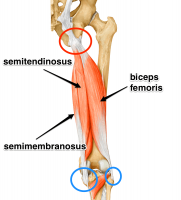
Don't expect to see him anytime soon.
Hamstring injuries that occur at the very top of the thigh are known as proximal hamstring tears. The reason for their special recognition is that these proximal hamstring injuries are more likely require surgery, whereas most all central and distal hamstring tears can be treated conservatively.
Hamstring tear classification system is based on the anatomical location of the injury, including Proximal [circled in red below] (injury of the tendon origin at the ischial tuberosity) Central (injury of the muscle belly, which is by far the most common pattern) Distal [circled in blue below] (injury of the distal musculotendinous insertion and tendons)

Don't expect to see him anytime soon.

